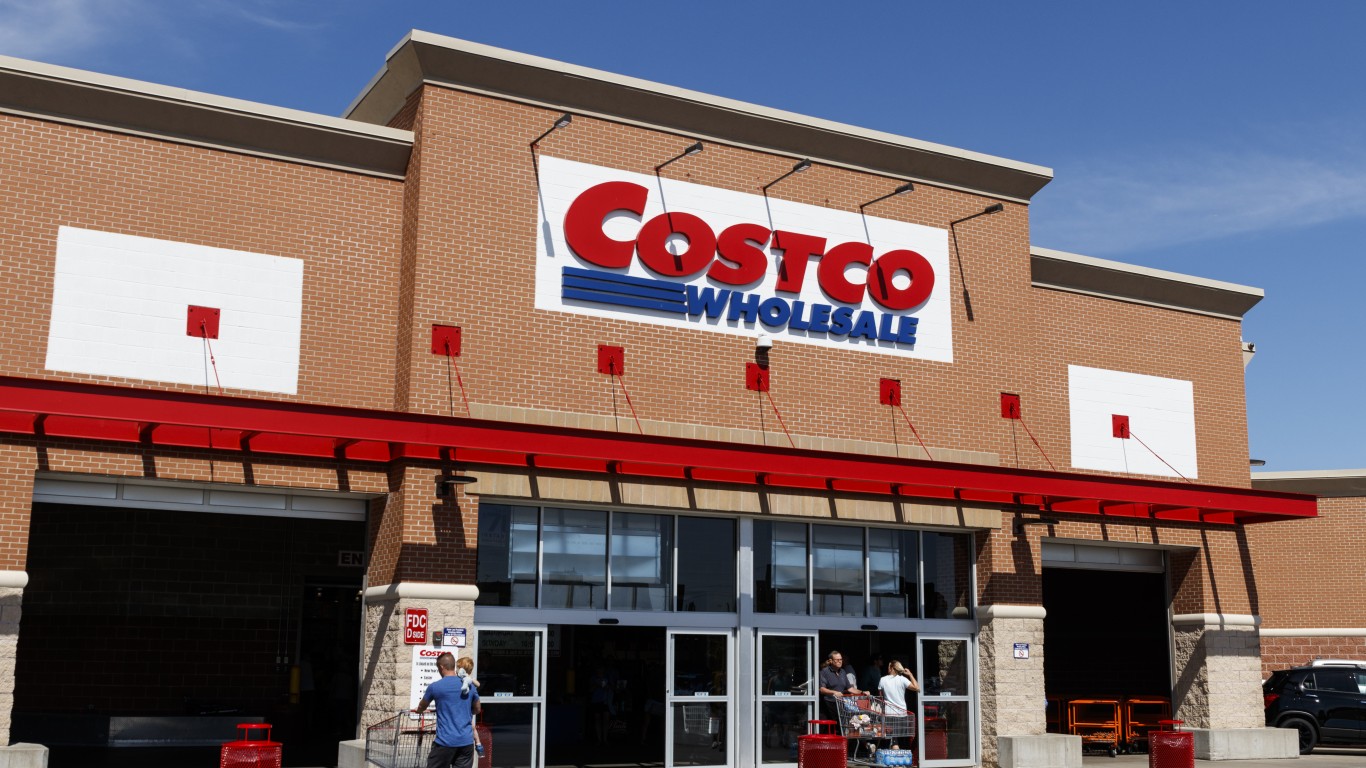 Filene’s Basement and parent company Syms declared bankruptcy recently. The situation is so grim that Syms will shutter all 46 locations, and 2,500 employees will lose their jobs. The company, founded in 1959, was once an important discount retailer. According to the company, it has been suffering from competition as sales of big apparel brands have become concentrated at large retailers with hundreds of outlets.
Filene’s Basement and parent company Syms declared bankruptcy recently. The situation is so grim that Syms will shutter all 46 locations, and 2,500 employees will lose their jobs. The company, founded in 1959, was once an important discount retailer. According to the company, it has been suffering from competition as sales of big apparel brands have become concentrated at large retailers with hundreds of outlets.
Skip to the eight worst-performing retail chains in America
Analysts predict that the holiday shopping season will be difficult for many retailers this year. The National Retail Federation reported that industry sales will be up only 2.8% to $465.6 billion, not enough to make up for three brutal years. Thousands of stores have been closed as a consequence of a drop in retail activity because of the recession. Stores closures for many retailers will continue.
Several of the largest retailers have consistently performed poorly between 2005 and 2010 for reasons that go beyond the recession. 24/7 Wall St. has identified the eight retailers that lost the most in total sales during that period. The stores that fared the worst have a great deal in common.
First, some specialty retailers compete with larger chains. This is certainly the case for Foot Locker because the big box retailers and most department stores sell high-end athletic shoes.
The presence of direct competitors that are similarly sized is yet another reason for the poor performance of some stores on the list. The office products retail sector is occupied by Office Depot, Office Max and Staples. Walmart’s Sam’s Club has created lines of merchandise that also compete in the same market.
The third reason that some of the retailers have done poorly is weak management. Robert Nardelli was a former Jack Welch lieutenant at GE. Nardelli was passed over for Welch’s job. He was hired by Home Depot to run the company after he failed to get the promotion. Between 2000 and 2007, Nardelli managed to alienate both employees and shareholders with poor results and his extravagant pay packages. JCPenney has had similar management problems. Poor merchandising decisions by CEO Mike Ullman, who has run the company since 2004, hurt revenue. He was recently replaced by the head of Apple’s retail store operation, Ron Johnson.
The retail industry has fared relatively well in the past five years, despite the recession, buoyed by strong sales during 2005 to 2007. GDP grew by 16% over these same five years. Also, most big operators have been able to increase revenue since the middle of the last decade. U.S. Sales at industry giants such as Walmart, Target and Costco have risen by 21%, 13% and 28%, respectively. With $600 billion a year in combined sales, the trio are a reasonable proxy for the entire industry.
To identify the large retailers in America with the worst sales, 24/7 Wall St. reviewed data published by National Retail Federation’s Stores Magazine. We relied on “Top 100 Retailers” list to identify the retailers that had lost the most in annual retail sales from 2005 to 2010. Only public companies were ranked in order to demonstrate how declining sales affect the overall health of corporations. Because sales numbers can be distorted, companies with significant M&A activity were also excluded.
These are America’s eight disappearing store chains.
8. JCPenney
> Drop in sales: 5.9%
> 2005 sales: $18.8 billion
> 2010 sales: $17.7 billion
> 5 yr. change in stock price: -59%
JCPenney is an iconic U.S. brand. It was started by James Cash Penney in 1902. At one point, it employed Sam Walton, the founder of Walmart. JCPenney suffers from two problems. The first is that it is in the highly competitive middle-market department store business, which includes Kohl’s, Macy’s and Dillard’s. Poor management has allowed competitors to flank the company in store locations and merchandise selection. Mike Ullman, who joined the company as CEO in 2004, was the head of JCPenney during its decline. Problems at the retailer have been severe enough that the board has replaced Ullman with former Apple Store chief Ron Johnson. Looking to the future, Penney’s typical middle class customer may have little discretionary income for spending this year. JCPenney same-store sales dropped 2.6% in October.
7. The Gap
> Drop in sales: 9.4%
> 2005 sales: $16 billion
> 2010 sales: $14.5 billion
> 5 yr. change in stock price: -3%
The situation at Gap has become more desperate recently. It announced it would close 21% of its flagship store locations by 2013. The Gap, which was founded in 1969, was the cool location for casual dress during the 1990s, capturing the nation with its slogan, “Fall into the Gap.” Until recently, the company had 3,100 stores, including Gap, Old Navy and Banana Republic locations. The Gap’s competition has grown both because of merchandise decisions at large department stores and the rise of retailers like Abercrombie & Fitch. Gap has been through several CEOs since it fired its famed chief Mickey Drexler.
6. Foot Locker
> Drop in sales: 12.3%
> 2005 sales: $5.7 billion
> 2010 sales: $5.0 billion
> 5 yr. change in stock price: -3%
In 1974, Woolworth, another famous American retailer, founded Foot Locker to take advantage of the growing interest in athletic shoes. Nike was started ten years earlier, and a surge in interest in athletic shoes had begun. Unfortunately for Foot Locker, Nike shoes are now sold by almost every department store and big-box retailer in the United States. Also, the parent company of Nike as well as Adidas and Under Armour have taken a larger part in building their brands, in some cases by having their own stores. Foot Locker’s sales did rebound in the second quarter of the year.
5. The Home Depot
> Drop in sales: 16.6%
> 2005 sales: $81.5 billion (restated to $77.1 billion due to HD Supply, August 2007)
> 2010 sales: $68.0 billion
> 5 yr. change in stock price: flat
The Home Depot is the world’s largest retailer of building materials and home improvement products. The company has over 2,200 stores worldwide. The chain has been badly damaged by the housing crisis, which began in earnest in 2007. Home Depot’s prospects were also hurt by the presence of Robert Nardelli, who operated the chain in the first half of the decade. One of Home Depot’s greatest challenges is that it has a large direct competitor in Lowe’s. The other is that the housing market has shown no sign of a recovery.
4. Office Depot
> Drop in sales: 16.8%
> 2005 sales: $14.3 billion
> 2010 sales: $11.9 billion
> 5 yr. change in stock price: -89%
All three of the major office supply companies — the other two being OfficeMax and Staples — have done poorly for three reasons. First, there are too many competitors in the sector. Second, retailers from outside the sector, particularly the Walmart/Sam’s Club franchise, have further divided market share and depressed the margins. The last and most obvious challenge is the toll taken by the recession, particularly among the small businesses that frequent these stores. Office Depot’s last quarter disappointed Wall Street. Sales for the period were off by 2%.
3. OfficeMax
> Drop in sales: 22.8%
> 2005 sales: $9.2 billion
> 2010 sales: $7.1 billion
> 5 yr. change in stock price: -83%
Office Max is the smallest of the three retailers in the office supplies industry, with a total annual revenue of $7 billion, compared with $25 billion for market leader Staples. Staple’s size and number of locations make it almost impossible for OfficeMax to gain market share. Its modest revenue also prevents it from having the purchasing and distribution leverage that its bigger rivals do. OfficeMax’s revenue fell 2.2% in the last reported quarter. The firm blamed weak back to school sales.
2. Dillard’s
> Drop in sales: 23.1%
> 2005 sales: $7.8 billion
> 2010 sales: $6.0 billion
> 5 yr. change in stock price: +82%
Dillard’s is another huge American retailer founded in the first half of the century that now finds itself in the crowded general department store sector, which includes Saks and Macy’s. All three companies have struggled to expand and have posted only modest net incomes. Dillard’s has staged a modest recovery recently. Same-store sales rose 8% in October.
1. Sears
> Drop in sales: 23.5%
> 2005 sales: $54 billion
> 2010 sales: $41.3 billion
> 5 yr. change in stock price: -53%
Sears Holdings was created in November 2004 by a merger between Sears Roebuck and Kmart. Sears Roebuck was once among the largest retailers in the country and essentially created the catalog business. The merger was engineered by hedge fund manager Eddie Lampert. Both of the chains were weak before the transaction. Kmart was in bankruptcy. Management has been unable to improve the company’s fortunes, which to some extent are hurt by the size and discounting power of Target and Walmart. Sears missed earnings expectations in the past quarter and said it had closed 29 stores during the period.
Douglas A. McIntyre
Essential Tips for Investing: Sponsored
A financial advisor can help you understand the advantages and disadvantages of investment properties. Finding a qualified financial advisor doesn’t have to be hard. SmartAsset’s free tool matches you with up to three financial advisors who serve your area, and you can interview your advisor matches at no cost to decide which one is right for you. If you’re ready to find an advisor who can help you achieve your financial goals, get started now.
Investing in real estate can diversify your portfolio. But expanding your horizons may add additional costs. If you’re an investor looking to minimize expenses, consider checking out online brokerages. They often offer low investment fees, helping you maximize your profit.
Thank you for reading! Have some feedback for us?
Contact the 24/7 Wall St. editorial team.



